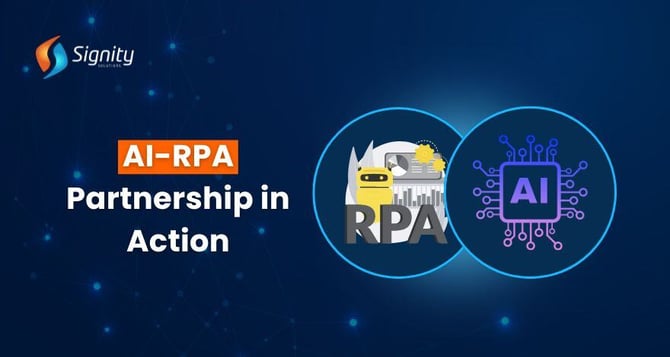How AI and RPA Work Together?
Have you ever wondered what would happen if two stellar forces—AI and RPA joined hands? Read on to discover how to implement this combination in your business, reap its benefits, and mitigate any challenges that might arise.

Anything done repeatedly over a long period becomes mundane. Studies show that we use just 10% of our brains daily. Add to that repetitive tasks that you have to do every day, and it will surely lead to cognitive fatigue.
What’s the solution, then? A solution that automates tasks, streamlines work processes and saves time. This is where Intelligent automation makes an entry.
According to an IDC report, 85% of businesses will implement AI, ML, and NLP by 2226.
The two main avenues of intelligent automation are RPA and Artificial Intelligence. While RPA is a subset of Business Process Automation and relies heavily on processes, AI is more data-driven and performs complex tasks that were previously possible only by humans.
Key takeaways
- AI and RPA are very powerful when combined together
- However, the implementation process is not easy, as one needs to select the right software tools.
- AI-powered RPA has use cases in almost every domain now, from healthcare to cybersecurity.
- If one knows how to navigate the minor roadblocks, one can harness the power of AI and RPA like never before.
What is the Difference Between AI and RPA?
Since their inception, there has been a major need for clarification about the two. People often consider them to be similar, but there are a number of stark differences between them.
- While RPA mainly relies on certain rules to perform at its fullest, AI relies on certain technologies, such as NLP and ML.
- The main aim of RPA implementation is to automate processes and save time, thereby increasing operational efficiency. The main objective of AI is to replace human labor altogether.
- Once you implement RPA into your software, you don’t have to interact with it again. Based on set rules and commands, it will keep working in the background and keep automating workflows. AI, the other hand, is more interactive and can modify it.
- When it comes to adaptability, AI systems are way more adaptable and can provide actionable insights based on human interaction with the system. AI use cases include monitoring stock markets and recommending your next restaurant. They can even predict the weather and can help you learn a new language.
How Can AI and RPA be Combined?
- The first step is to identify your business needs and end goals. Keep actionable insights on your to-do list.
- Keep an eye on real-time data and analyze your workflows. In this step, you need to eliminate the loopholes, which range from recruitment/ hiring and retention to inflation or even lack of capital.
- Next, prepare a very detailed business case. This will include the use cases of AI-powered RPA and a detailed breakdown of the calculated ROI. You can even get in touch with RPA consulting services, which can help you with differentiating between AI use cases and RPA use cases.
- Educate your team players and employees on how implementing AI-powered RPA would benefit the organization, and you can even seek advice from them. This is the most vital step in the process: select a very good automation tool for your business. If you're just starting out with RPA implementation, consider low-code or no-code software.
- Next, combine your AI systems with RPA tools.
- You have to train your AI models based on your specific RPA use cases or pain points.
- You need to define your automation workflows and decide how the different components will interact within the system.
- Once you deploy the AI and RPA system in your organization, you need to test whether it is running according to your needs. The best way to gauge this is to assign KPIs to the system and track it consistently.
Let's Discuss the Benefits of Combining AI and RPA
- Reduced operational risks
- Increased efficiency
- Enhanced ROI
- Better customer support
- Better analytical capabilities
- More data collection
- Better IT support
Combining AI and RPA enhances operational efficiency by automating repetitive tasks and enabling intelligent decision-making, ultimately driving cost savings and accelerating business growth.
-
Reduced operational risks
The AI-powered RPA system operates according to a pre-set collection of rules, and they follow the instructions to a T. Hence, mistakes are reduced, and the system is not disrupted. This is the most common benefit in RPA use cases and would not have been possible if done by a single person or a group of people.
-
Increased efficiency
What can be worse than assigning mundane, repetitive tasks to your employees and seeing your organizational efficiency sink because of it? When you implement AI and RPA into your system, they will take care of the repetitive processes, and the team members can actually brainstorm and bring new ideas to the table.
-
Enhanced ROI
AI and RPA combined provide tangible ROI benefits to your organization. A simple formula can help you achieve this.
ROI= (Total benefits/ total costs x 100)
-
Better customer support
The main function of AI-powered RPA in customer service is to provide immediate responses and modify them based on customer interaction and reactions. AI combined with RPA can aid in a number of other things like voice assistance, automating the processes in call centers, etc
-
Better analytical capabilities
If you want better transparency and detailed business analytics reports, a platform like Tableau hardly serves your purpose. Intelligent automation and AI take center stage here.
Deriving real-time insights from the data is also crucial, which is made possible by deploying advanced RPA-AI technologies. To enable buy-ins within your organization, it is important to access and share the insights as soon as possible with different stakeholders, and the AI-powered RPA tool helps with that task as well.
-
More data collection
Imagine a human being who is made to examine large data sets and extract data from tens of thousands of documents. He is going to take umpteen hours to do the same and is going to be distressed at the end of the process. Moreover, the entire process is prone to human errors.
What if, in his place, a “bot” is assigned the same task? It will scan through websites, databases, files, and documents in just a few seconds, gather the data, and then consolidate the same in structured formats easily decipherable to the audience. This will not only save time but also enhance data consistency and accuracy.
-
Better IT support
RPAs can help develop chatbots and provide voice chat assistance. In most IT companies, there is a thing called “Cost Per Ticket.” It is the average cost incurred by IT companies in resolving a customer’s issue. This will significantly reduce the deployment of AI and RPA since the automated bots will take considerably less time to solve a problem.
Examples of AI-Powered RPA
-
Creating marketing campaigns
RPA eliminates the bottleneck in marketing campaigns, which is consumer behavior. It helps in data collection and analysis. RPA automatically adjusts bids for PPC campaigns and generates technical SEO reports. When it comes to the sales funnel, it helps in nurturing leads by assigning specific scores to them based on algorithms. By utilizing AI, customers can help identify potential leads from the target audience and identify existing market gaps to fill.
-
Product development
Firstly, AI-powered RPA can help identify customer needs, foresee how they plan to use the product, and predict the potential benefits of using the product in their lives. It allows companies to conduct market research, especially in processes like pricing analysis and also enables AI developers to create prototypes for software products. It helps in intermediate stages, like regression testing, and can aid in user-acceptance testing, too, by generating feedback.
-
Healthcare domain
In the healthcare industry, AI-powered RPA can help provide 24/7 personal assistance to patients, alongside aiding data management and managing records for health providers and patients. IoT (Internet of Things) is a network of connected devices that have given rise to wearables that monitor your heart rate and pulse rate, as well as IoT devices that monitor the live location of wheelchairs. Health insurance companies can use IoT for underwriting and the detection of fraudulent claims.
In the year 2023, 805 billion U.S. dollars were spent on IOT devices worldwide.
-
Banking and Finance
The main goal of banks' customer service departments is to reduce turnaround time while resolving customer queries. From handling every process from customer verification to generating financial statements like General ledger, RPA combined with AI can basically do everything in the banking industry. RPA-powered AI can save banks millions of dollars by facilitating KYC verification, identifying potential frauds, and ensuring cybersecurity.
-
Human Resource Manangemet
AI-powered RPA can help human resources management by sifting through resumes and tracking employee performance by keeping track of their work throughout the year. Not only that, the duo will generate reports for the HR manager to review, including data regarding the employees' key strengths and areas of improvement.
Survey tools powered by AI could help create feedback forms, which can aid in effective employee sentiment analysis. Some firms can even deploy HR bots and virtual assistance tools that can answer employee queries regarding leave policies and the work culture of the firm
-
Real estate
The first and foremost use of RPA in the real estate industry is tax billing. Moving a client’s data from mail to an ERP system tailored for real estate operations, managing administrative practices, and helping in tax legalization - are all made seamless by the utilization of AI and RPA.
Automated bots can also help scale up operations, and all of these combined can help a firm adhere to compliance requirements. AI-driven property intelligence enhances decision-making by providing insights on valuations, market trends, and risk assessments, further optimizing real estate operations. When it comes to tenant onboarding, RPA and AI can run background checks and verify income and references.
-
Cybersecurity
If you are the cybersecurity expert at some big organization that garners a lot of traffic, it is not possible for you to keep track of all the information and review potential threats. AI identifies the weak links in an organization and suggests critical security tasks to be performed in order to enhance security measures. The thing with cyber-miscreants these days is that they are constantly learning new tricks and bettering their game. It is not feasible for a human expert to keep track of changing behavior continually. AI combined with RPA can perform repetitive tasks like constantly analyzing the networks and securing authentication.
-
Education
Personalized Learning is the most important use case when it comes to leveraging AI and RPA. The technology keeps an eye on how the learner is able to grasp the concepts and how much time he is taking and then designs the curriculum for him accordingly.
Apart from this, it can help organize reports, grade a student’s performance, help with homework and research projects, solve maths problems, teach complex science topics, and make AI presentations. By leveraging 2D-3D visualization technology, AI can help children absorb concepts faster than batting an eyelid. Some educative AI tools offer multilingual super, too, thus making it convenient for kids from different demographics to learn things freely.
Common Challenges in AI-driven RPA
-
Lack of skilled professionals
Having a skilled technical team is essential if you are looking to implement AI and RPA in your system. Deployment of the RPA-AI duo is not the end goal of any business; an effective system should be adept at handling technical changes. Instead of hiring new employees who are skilled in these technologies, the existing team members can also be provided with cross-functional training, which might result in closing the skill gaps.
-
Complexity of processes
Sometimes, projects fail because the underlying processes are too complex, and the team members might need more knowledge about the complexities. Proper process analysis and an agile environment are the bare minimum prerequisites to navigate this roadblock.
The more complex a process is, the longer it will take for the implementation of the AI and RPA technology to take place. Some complex processes can take up to 24 months or more. There might also be resistance from the workforce initially if the existing workflows are suddenly disrupted due to avant-garde experiments. An RPA consulting company can help you sail through this predicament with ease.
-
Lack of business support
Defining a bot execution schedule or chalking out an AI and RPA calendar as a whole is a cumbersome task. You have to rely heavily on the organization's roadmap and whether or not they have the necessary resources to allocate to software development and other processes. Once implemented, an AI-powered RPA system needs little to no maintenance, but a company should have the required infrastructure to support its successful operation. The production environment also needs to be suitable for the smooth running of the application.
-
Inappropriate use cases
Businesses should exercise great caution when listing AI and RPA use cases in the organization. If the use case is outside the scope of the RPA-AI system, implementing it will not affect efficiency and will eventually lead to a low ROI.
-
Not a well-defined work culture
If the organization is clear regarding the roles and responsibilities, streamlining workflow becomes smooth. Team collaboration is the biggest prerequisite for implementing AI and RPA in businesses, and a lack of it poses a serious threat to the overall deployment of the technology. It can also hinder trust and genuineness among team members. If team members become reluctant to cooperate with one another, implementation of a successful AI RPA system is a far-fetched idea
Taking The First Step Is Never Easy
But you can never know if you don’t go about it! Before you get started with AI and RPA implementation, it is worthwhile to contact an AI consulting company like Signity Sofware Solutions.
They can help you identify the risks and suggest ways to mitigate them. But more than that, a team of industry experts experienced in AI services can help you select the right AI tool and suggest more relevant use cases to multiply your ROI.



.png?width=344&height=101&name=Mask%20group%20(5).png)











![12 RPA Use Cases In The Real World [Updated 2024]](https://www.signitysolutions.com/hs-fs/hubfs/Imported_Blog_Media/RPA-Use-Cases-1024x512.png?width=352&name=RPA-Use-Cases-1024x512.png)







